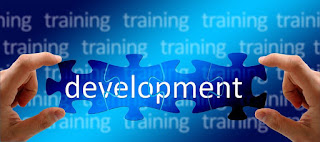13 Key Functions of Human Resource Management in every organization today and tomorrow
Human Resource
Management is that segment of management which deals with the effective control
and use of manpower. Effective management of human resources is one of the most
crucial factors associated with the success of an enterprise. Broadly, Human Resource Management (HRM) is
concerned with (a) Managerial (b) operative (c) advisory or strategic functions
of any organization related to its employees and the employer.
Off lately, I have been seeing people asking and
answering this simple question in many different ways, however, it is not going
to change its original meaning in any way.
With an endeavour to exhibit these simple functions
of Human Resource Management – all my efforts will be to present it in a
precise manner so that it is understandable for every person.
(a) Managerial
functions of Human Resource Management include:
Planning
Planning is the first and basic functions of Human Resources
which help in determining the course of action to be followed for achieving
various manpower objectives. It is a decision in
advance, what to do, when to do, how to do and who will do a particular task. It
involves the selection of organizational objectives and developing policies, procedures,
programs, budgets and strategies. Planning is a continuous process which needs
to be undertaken by its Human Resource Department while aiming for any objectives
related to its employees.
Organizing
Organizing is the second and most crucial functions
of Human Resource Management. The functions of organizing are to identify, classify
and assign activities, delegate authority, fix responsibility and coordinate the relationship for the purpose of enabling people to work most effectively
together in accomplishing enterprise objectives.
Directing
After Planning and organizing the next critical functions
of Human Resource Management is directing. This particular function concerns
the total manner in which a Human Resource Manager influences the actions of others
inside the enterprise.
The core actions involved
in directing are - Leadership, Communication,
Motivation and supervision.
Controlling
If planning is the beginning of the Human Resource
Management functions, controlling may be said to be the final stage. If planning is eyeing ahead, controlling is seeing back. Thus,
controlling is a method which enables Human Resource Management to get its
policies implemented and take corrective actions if performance is not according to the preset standards.
Largely
process of controlling involves a few steps: Forming standards of
performance, evaluating actual performance, comparing the actual performance with
the standard, finding variances or deviations (if any), and taking corrective
action or measures.
(b)
Operative Functions of Human Resource Management include:
Recruitment,
talent acquisition, hiring or maybe known as procurement –
- Of
right kind and number of persons inside the enterprise. This function starts
from manpower planning, looking out for sources of hiring that manpower, inviting,
collecting & screening of resumes, conducting interviews, making offer and
finally inducting & orienting them into the organization.
Human Resource Development (HRD) –
Is a
strategy to bring about the changes in employees so that new challenges are
met. HRD wishes to advance an individual employee in accordance with his aspirations and potentialities on
the one hand and the company’s requirements on the other. HRD programs are described as Training and Educating Initiatives
undertaken by Human Resource management Representatives from time to time
in an organization.
There are six dimensions of HRD namely - Performance Appraisal, Potential Appraisal,
Employee counselling, career development and planning, training, organizational
development. Thus, any HRD initiative is intended to refine the potentialities
of people to perform well on their job.
Compensation
& Benefits –
The main objective of this operative function of
Human Resource Management is to govern suitable, equitable and competitive
compensation& benefit of employees. Deeply this function includes making
salary, benefit, incentives structures, preparing & disbursing monthly
payroll, computing income tax, issuing form 16, designing incentives structures
and taking care of grievances related to any aforesaid divisions. Besides
taking care of employee-related laws/compliances, for instance, EPF, ESIC, Gratuity,
Bonus, Minimum wages etc. are also part of this operative function of Human
Resource Management.
Retaining
Suitable persons –
The rapid developments of technology are throwing new challenges every day. Modernization of various techniques, computerization
of data processing, and the introduction of micro-process controlled machines, a revolution in communication techniques has resulted in a demand for trained and
highly skilled persons. HRM not only helps in procuring suitable persons but
also useful in retaining them, there may be a redundant workforce because of
various developments; efforts should be made to offer golden handshape to them.
As a tool of retention appropriate Employee engagement
initiatives should be implemented in the form of – staff get-togethers,
celebrating specials festival or occasions, off-sites, reward & recognition
programs, external workshops, Thank you note etc.
Creating
work culture, working condition and welfare –
HRM approach should be such that the aims and
aspirations of individual workers are given due weightage in the scheme of the organization.
Human Resource policy should be backed by human values, understanding and
concern for the welfare of its people. Work culture should be free of bullying or
harassment and every person should be treated with dignity and moreover no room
of diversity. Proper handling of disputes, maintaining employee relations and
appropriate grievance handling mechanisms should be in place. Consequently, the overall culture of the organization improves; people feel satisfied and enjoy
their work.
Appropriate welfare measures in the form of health
& safety, work-life balance, employee & family insurance, cafeteria, rest
rooms, adequate breaks, leave policy should also be in place to secure employee
and to protect the employer whenever required.
Conducting
Employee satisfaction survey or research –
Human Resource Management will be successful only
if we know the aspirations and expectations of various persons working in the organization.
The framing of Human Resource policies, strategies and approaches depend upon
the information collected through surveys like Great place to work, Salary The survey, Gallup etc. Further, depending upon the outcome of the survey initiating
corrective or preventive measures respectively.
Developing a
communication System –
Human Resource Management supports the development
of the downward, upward and lateral system of communication where policies of the
management are properly conveyed to the lowest level of hierarchy and feedback
from the lower level is communicated to the top management. Effective communication the system helps in understanding the viewpoints of each other and taking up
remedial steps, if required.
Employee Separations
–
The last but equally significant function of Human
Resource Management is to take care of the exit or separation formality of
employees whether it’s voluntary or accidental.
In the event of voluntary separations HR
Representative should complete the Full and final process as per company
standard policy without creating any hassle for departing employee. On the other hands, for the second category of employees, they should take care of the
mental health of the respective employee and the goodwill of the company together.
(c) Advisory or Strategic Functions of Human Resource Management include:
Educating
and advising Top Management and the Functional (department) Management –
The Human Resource Management (HRM) approach will
succeed only when Top, as well as managerial personnel, change their attitude
towards the workforce. There is a need to educate executives, managers and top
management regarding various aspects of the human resource approach adopted in
the organization.
Hope aforesaid 13 key functions of Human Resource Management in every organization today and tomorrow
are of help for every reader.



Comments
Post a Comment
Please do not add any spam link in the comment box